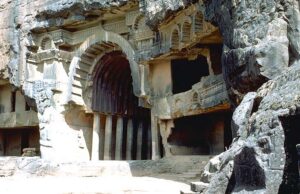
Bhaja is one of the important Buddhist centres of Hinayana faith in Maharashtra. The group consists of 22 excavations and located on a hill near Bhaja village, Maval Taluka in district Pune.
The importance of Bhaja is further enhanced by the presence of two more monastic complexes namely Bedsa located on the south face of the same hill in which Bhaja is situated and Karla, directly opposite north of Bhaja nearly 5 Km from the latter. All the caves belong to the Hinayana phase and are datable from 3rd century BC to 2nd century AD. However the group was under occupation up to 5-6th century AD as attested from some of the painted Buddha images in the chaityagrha. They are excavated on a scrap of the hill at a weight of 120 m from above the surrounding plains and all faces west. The river Indrayani is located nearby and waters the valley.
Bhaja Caves are famed due to their ornate facades. Stone carvings in Bhaja caves are not very deep, style is similar to the one of the molded terracotta. Sculptures in Bhaja have elaborate headdress, garlands, jewellery. It is possible that initially these sculptures were covered with plaster and painted in bright colors. As it is characteristic for early Buddhism, the religious art of caves is characterized with symbolic representation of Buddha.
The excavations here consist of chaityagrhas, viharas and podhis.
The most prominent among the excavations is the chaityagrha. The chaityagrha is considered to be the earliest of its kind and a close copy of wooden prototype. On plan it consist of a large apsidal hall measuring 17.08 m is length and 8.13 m his width. The hall is divided into a central nave and side aisles by 27 pillars in tow straight road which meets in a semi circle at the back. The ceiling of the nave is vaulted and original wooden beams are fixed. The pillars are plain octagons and they taper inwards, as it would have been required in wooden structures as this is a copy of an existing wooden structure. The inward slope of pillars is required in a wooden structure to cope up with the outward thrust from the top. A stupa is placed at the back for worship. The stupa has a prominent hemispherical dome on a cylindrical drum crowned by a railing pattern (harmika) and provision of hole for a top for inserting a wooden umbrella.
At present, the entrance of the hall is completely open. However, the evidence of mortise holes indicates the presence of a wooden façade below the chaitya arch and also wooden screen of the chaitya window. The façade of the chaityagrha is highly decorated and present a true replica of a 2nd century B.C. wooden architecture. On either side of the central arch are series of miniature chaitya arches over railing patterns.
Cave 18 is a monastery and consists of a rectangular hall with a front pillared verandah. The hall has two cells each on the back and right side, while on the left side is a bench. Unlike the pillars of the chaityagrha the pillars have square base and top with octagonal shape at the middle. Two doors from the verandah lead to the hall; they are flanked by lavishly bejeweled dvarapalas. The verandah of this monastery has two famous sculptural reliefs which are most important. One depicts a royal personage attended by two women, driving in a chariot driven by four horses, which tramples on a demonic figure. The person in royal attire has been identified by some as Sun god Surya. To the left of the door is depicted a person driving an elephant carrying an ankusa (elephant goad), with attendants carrying a banner and spear. The figure has been identified by some as Indra.
Apart from Cave 18, which is highly decorative and elaborate the group of Caves at Bhaja has other monasteries of simple type, halls with verandah, the former having cells, on one, two or three sides. Some exceptions are also noticeable, like the ones with a circular cell and a stupa inside; circular cell with oblong verandah etc.
One irregular excavation is identified as a cemetery, which has fourteen rock-cut stupas, some inscribed with the name of sthaviras.
Source:
http://asi.nic.in/asi_monu_tktd_maha_bhajacaves.asp
http://www.columbia.edu/itc/mealac/pritchett/00routesdata/bce_099_000/bhaja/bhaja.html


